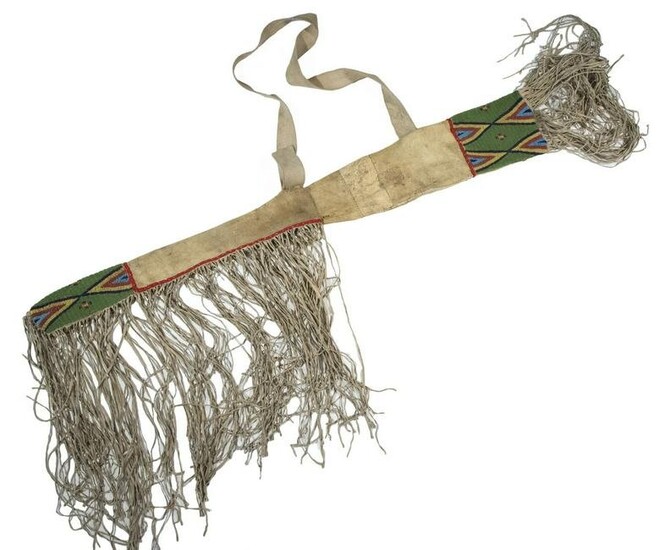FORT PECK LAKOTA RIFLE SCABBARD MADE BY BLACK DOG FOR
North Plains Indian Wars Survivor, brain-tanned hide, decorated in the style of the Hunkpapa Lakota Sioux, originally done for a carbine or short gun, then extended, with early lazy-stitched pony beading in blue, yellow and red on green and Togia glyphs (iconic native language) for Sitting White Buffalo, and Black Dog, his mother (made by her for her son, born in 1852), retains fringe and original pony strap. 41" long plus 15" fringe. Marked with coup.Per Wendell Grangaard of Guns of History, Sioux Falls, SD: "From a young age, he (Sitting White Buffalo) was raised by his mother, after his father was killed by the Crow. His father belonged to the Kangiska band of Hunkpapa, so when Sitting White Bull came of age, he joined this band, who at that time was headed by Gall. At the Battles of Rosebud and Little Big Horn, Sitting White Buffalo rode with Gall and Kangiska. When Gall and his band went into Canada, Sitting White Bull, his mother and his sister A Voice That Can be Heard followed. He and his family surrendered in 1881 with Gall and 52 other families. Sitting White Buffalo settled and lived the rest of his life near Gall on the Standing Rock Reservation."The area of Ft Peck was a hotbed during the Indian Wars. Originally surrounded by both Assiniboine and Sioux (Hunkpapa and Lakota) in 1870, then President Grant designated Ft Peck reservation status and awarded the tribes to the Methodist Missionaries. This was done as an experiment whereby the US military presence and influence was to be decreased by placing the reservation work under missionary control.Ill-fated, the Sioux Warriors of Ft Peck joined with Sitting Bull during the Sioux campaigns of 1876-77. In retaliation, rations were cut by the US Government to the reservation and then with the drought of 1883 the Indians were faced with starvation. Years later in 1896, the government discontinued missionary aid to the Indian populations.Purchased from Michael Kokin at Sherwoods Spirit of America in Santa Fe, NM, 07/31/2007.
[ translate ]Estimate
Time, Location
Auction House
North Plains Indian Wars Survivor, brain-tanned hide, decorated in the style of the Hunkpapa Lakota Sioux, originally done for a carbine or short gun, then extended, with early lazy-stitched pony beading in blue, yellow and red on green and Togia glyphs (iconic native language) for Sitting White Buffalo, and Black Dog, his mother (made by her for her son, born in 1852), retains fringe and original pony strap. 41" long plus 15" fringe. Marked with coup.Per Wendell Grangaard of Guns of History, Sioux Falls, SD: "From a young age, he (Sitting White Buffalo) was raised by his mother, after his father was killed by the Crow. His father belonged to the Kangiska band of Hunkpapa, so when Sitting White Bull came of age, he joined this band, who at that time was headed by Gall. At the Battles of Rosebud and Little Big Horn, Sitting White Buffalo rode with Gall and Kangiska. When Gall and his band went into Canada, Sitting White Bull, his mother and his sister A Voice That Can be Heard followed. He and his family surrendered in 1881 with Gall and 52 other families. Sitting White Buffalo settled and lived the rest of his life near Gall on the Standing Rock Reservation."The area of Ft Peck was a hotbed during the Indian Wars. Originally surrounded by both Assiniboine and Sioux (Hunkpapa and Lakota) in 1870, then President Grant designated Ft Peck reservation status and awarded the tribes to the Methodist Missionaries. This was done as an experiment whereby the US military presence and influence was to be decreased by placing the reservation work under missionary control.Ill-fated, the Sioux Warriors of Ft Peck joined with Sitting Bull during the Sioux campaigns of 1876-77. In retaliation, rations were cut by the US Government to the reservation and then with the drought of 1883 the Indians were faced with starvation. Years later in 1896, the government discontinued missionary aid to the Indian populations.Purchased from Michael Kokin at Sherwoods Spirit of America in Santa Fe, NM, 07/31/2007.
[ translate ]


